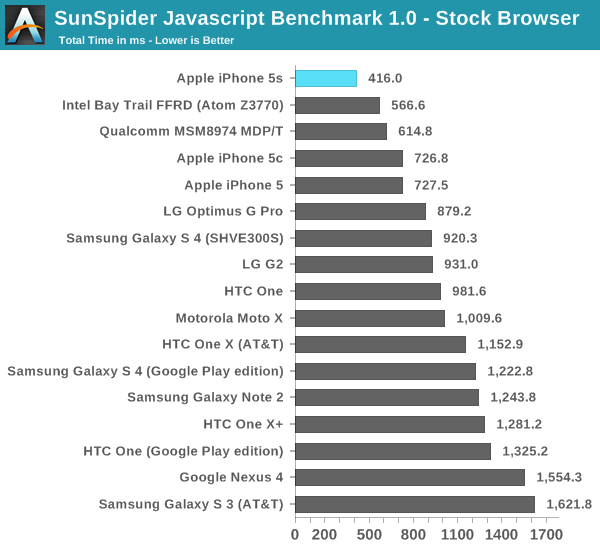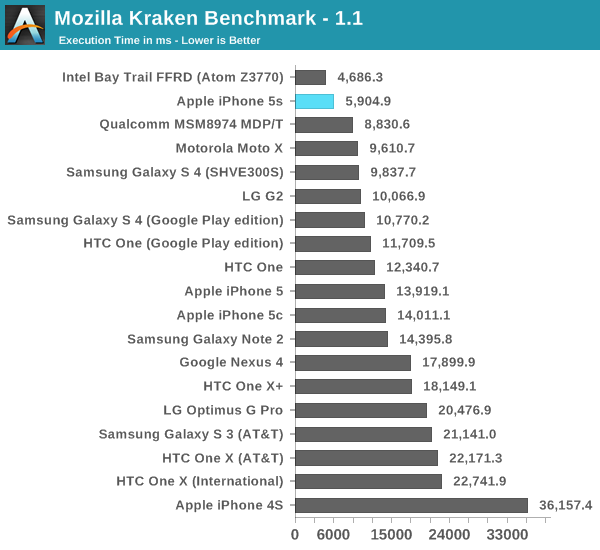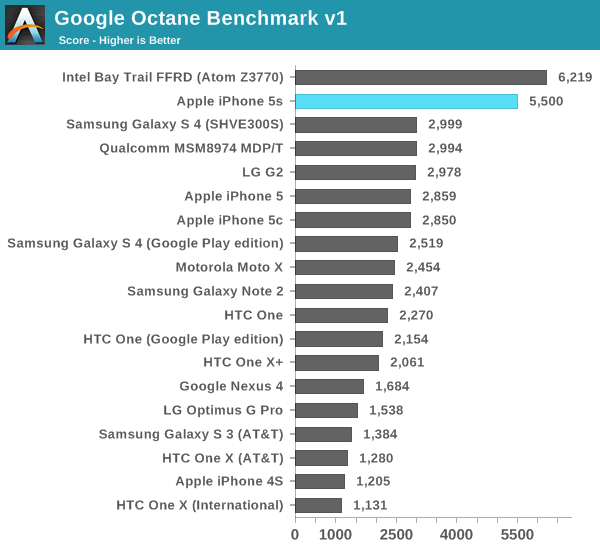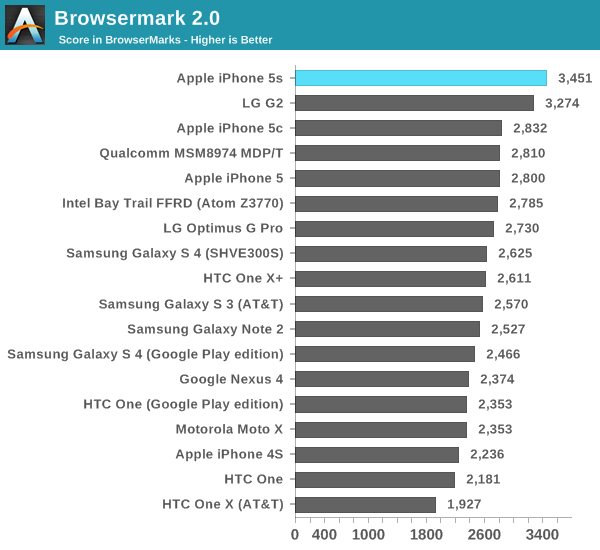The iPhone 5s Review
by Anand Lal Shimpi on September 17, 2013 9:01 PM EST- Posted in
- Smartphones
- Apple
- Mobile
- iPhone
- iPhone 5S
CPU Performance
For our cross-platform CPU performance tests we turn to the usual collection of Javascript and HTML5 based browser tests. Most of our comparison targets here are smartphones with two exceptions: Intel's Bay Trail FFRD and Qualcomm's MSM8974 Snapdragon 800 MDP/T. Both of those platforms are test tablets, leveraging higher TDP silicon in a tablet form factor. The gap between the TDP of Apple's A7 and those two SoCs isn't huge, but there is a gap. I only include those platforms as a reference point. As you're about to see, the work that Apple has put into the A7 makes the iPhone 5s performance competitive with both. In many cases the A7 delivers better performance than one or both of them. A truly competitive A7 here also gives an early indication of the baseline to expect from the next-generation iPad.
We start with SunSpider's latest iteration, measuring the performance of the browser's js engine as well as the underlying hardware. It's possible to get good performance gains by exploiting advantages in both hardware and software here. As of late SunSpider has turned into a bit of a serious optimization target for all browser and hardware vendors, but it can be a good measure of an improving memory subsystem assuming the software doesn't get in the way of the hardware.

Bay Trail's performance crown lasted all of a week, and even less than that if you count when we actually ran this benchmark. The dual-core A7 is now the fastest SoC we've tested under SunSpider, even outpacing Qualcomm's Snapdragon 800 and ARM's Cortex A15. Apple doesn't quite hit the 2x increase in CPU performance here, but it's very close at a 75% perf increase compared to the iPhone 5. Update: Intel responded with a Bay Trail run under IE11, which comes in at 329.6 ms.
Next up is Kraken, a heavier js benchmark designed to stress more forward looking algorithms. Once again we run the risk of the benchmark becoming an optimization target, but in the case of Kraken I haven't seen too much attention paid to it. I hope it continues to fly under the radar as I've liked it as a benchmark thus far.

The A7 falls second only to Intel's Atom Z3770. Although I haven't yet published these results, the 5s performs very similarly to an Atom Z3740 - a more modestly clocked Bay Trail SKU from Intel. Given the relatively low CPU frequency I'm not at all surprised that the A7 can't compete with the fastest Bay Trail but instead is better matched for a middle of the road SKU. Either way, A7's performance here is downright amazing. Once again there's a performance advantage over Snapdragon 800 and Cortex A15, both running at much higher peak frequencies (and likely higher power levels too, although that's speculation until we can tear down an S800 platform and a 5s to compare).
Compared to the iPhone 5, the 5s shows up at over 2.3x the speed of last year's flagship.
Next up is Google's Octane benchmark, yet another js test but this time really used as a design target for Google's own V8 js engine. Devices that can run Chrome tend to do the best here, potentially putting the 5s at a disadvantage.

Bay Trail takes the lead here once again, but again I expect the Z3740 to be a closer match for the A7 in the 5s at least (it remains to be seen how high the iPad 5 version of Cyclone will be clocked). The performance advantage over the iPhone 5 is a staggering 92%, and obviously there are big gains over all of the competing ARM based CPU architectures. Apple is benefitting slightly from Mobile Safari being a 64-bit binary, however I don't know if it's actually getting any benefit other than access to increased register space.
Our final browser test is arguably the most interesting. Rather than focusing on js code snippets, Browsermark 2.0 attempts to be a more holistic browser benchmark. The result is much less peaky performance and a better view at the sort of moderate gains you'd see in actual usage.

There's a fair amount of clustering around 2500 with very little differentiation between a lot of the devices. The unique standouts are the Snapdragon 800 based G2 from LG, and of course the iPhone 5s. Here we see the most modest example of the A7's performance superiority at roughly 25% better than the iPhone 5. Not to understate the performance of the iPhone 5s, but depending on workload you'll see a wide range of performance improvements.










464 Comments
View All Comments
teiglin - Wednesday, September 18, 2013 - link
There is absolutely no basis to compare the process tech between A7 and Bay Trail. We know what battery life the A7 affords the iPhone 5s, but know nothing about what sort of battery life Silvermont might provide in a smartphone form factor. If those Oscar cores are really as power-efficient as Silvermont, then yes, that'd be amazing evidence of A7's power-efficiency.Wilco1 - Wednesday, September 18, 2013 - link
Given a 2.4GHz Bay Trail in a development board already cannot keep up with the A7 at 1.3GHz (A7 beats it by a huge margin on Geekbench), there is no hope for BT-based phones. BT would need to be clocked far lower to fit in a total phone TDP of ~2W, which means it loses out even worse on performance against A7, Krait and Cortex-A15.So yes, the fact that Bay Trail is already beaten by a phone before it is even for sale is a sign of things to come. 2014 will be a hard year for Intel given 20nm TSMC will give further performance and power efficiency gains to their competitors. It all starts to sound a lot like a repeat of the old Atom...
vcfan - Wednesday, September 18, 2013 - link
"Apple's designs are superior to Intel's. and then, Intel had better watch out."first of all, its arm vs x86. and second, it was "LOLz intel cant do low power chips,arm wins", now its "but but intel is 22nm" . hilarious.
ScienceNOW - Wednesday, September 18, 2013 - link
WE have plenty of time until 5nm, by that time most likely something New will be in place to pick up where silicone leftsolipsism - Tuesday, September 17, 2013 - link
Since when is a PS4 a desktop machine? And why only look at the GPU and not at the CPU that was clearly referenced?Crono - Tuesday, September 17, 2013 - link
Ha, I love the low-light image choice of subject. :DYou have to admit, it seems like Apple learned some things from Nokia and HTC this round to improve their cameras, though the combination dual flash is pretty ingenious. I'm wondering if the other manufacturers will adopt it or stick to single LED and Xenon flashes.
StevoLincolnite - Tuesday, September 17, 2013 - link
My Lumia has dual LED flashes, the Lumia 928 has dual Xenon flashes.So it's hardly anything new when the Lumia 920 has been on the shelf for almost a year.
whyso - Tuesday, September 17, 2013 - link
My HTC raider from 2011 has dual LED flash.Ewram - Wednesday, September 18, 2013 - link
my HTC Desire HD (HTC Ace) has dual led, bought it november 2010.melgross - Wednesday, September 18, 2013 - link
I think you missed the explanation of what Apple did here. The dual flashed in the past, and in yours and other current devices are just two flashes of exactly the same type. Apple's is one cold temp flash and one warm temp flash. The camera flashes before it takes the photo, then evaluates the picture quality based on color temperature. It then comes up with a combination of flash exposure that varies the amount each flash generates so as to give the proper color rendering, and well as the correct exposure.No other camera does that. Not even professional strobes can do that. I wonder if Apple patented the electronics and software used for the evaluation.